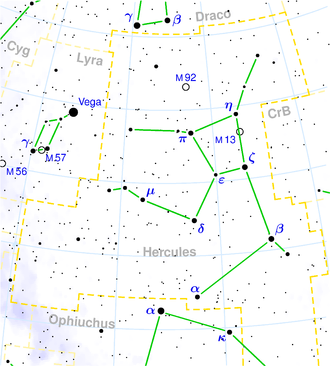NGC 6501
| Galaxy NGC 6501 |
|
|---|---|
|
|
|
| AladinLite | |
| Constellation | Hercules |
|
Position equinox : J2000.0 , epoch : J2000.0 |
|
| Right ascension | 17 h 56 m 03.743 s |
| declination | + 18 ° 22 ′ 23.07 ″ |
| Appearance | |
| Morphological type | SA0 +: |
| Brightness (visual) | 12.4 mag |
| Brightness (B-band) | 13.3 mag |
| Angular expansion | 1.8 ′ × 1.6 ′ |
| Position angle | 54 ° |
| Surface brightness | 13.4 mag / arcmin² |
| Physical data | |
| Affiliation | isolated NGC 6500 group LGG 414 |
| Redshift | 0.010234 ± 0.000037 |
| Radial velocity | 3068 ± 11 km / s |
|
Stroke distance v rad / H 0 |
(144 ± 10) · 10 6 ly (44.2 ± 3.1) Mpc |
| history | |
| discovery | Wilhelm Herschel |
| Discovery date | June 29, 1799 |
| Catalog names | |
| NGC 6501 • UGC 11049 • PGC 61128 • CGCG 113-009 • MCG + 03-46-04 • 2MASX J17560372 + 1822228 • GC 4349 • H III 958 • WISEA J175603.73 + 182223.0 • LDCE 1274 NED006 • KPG 526B | |
NGC 6501 is a 12.4 mag bright lenticular galaxy of the Hubble type S0 / a in the constellation Hercules in the northern sky . It is estimated to be 144 million light years from the Milky Way and about 75,000 light years in diameter . Together with NGC 6500 , it forms the isolated, gravitationally bound galaxy pair KPG 526 .
She is considered a member of the six galaxies counting NGC 6500 group ( LGG 414 ).
The object was discovered together with NGC 6500 on June 29, 1799 by Wilhelm Herschel with an 18.7-inch reflector telescope, which was called “Two (NGC 6500 & NGC 6501) both vF, vS; place that of the following one, preceding one about 4 ′ more south and 5 or 6 seconds preceding "noted.
